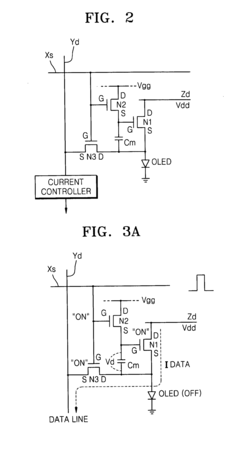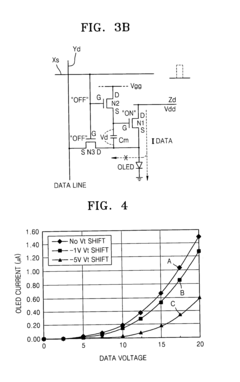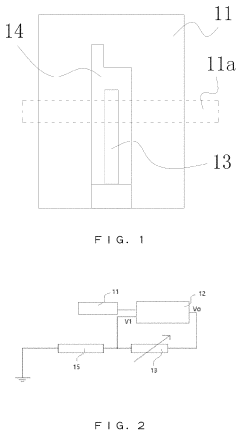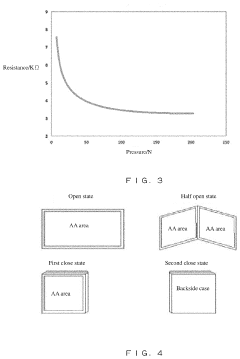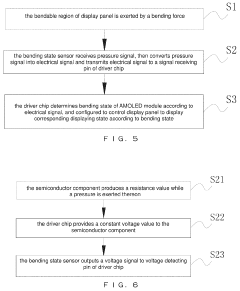Flexible AMOLED in dynamic digital advertising.
JUL 17, 20259 MIN READ
Generate Your Research Report Instantly with AI Agent
Patsnap Eureka helps you evaluate technical feasibility & market potential.
AMOLED Evolution and Objectives
The evolution of Active-Matrix Organic Light-Emitting Diode (AMOLED) technology has been a game-changer in the display industry, particularly in the realm of dynamic digital advertising. AMOLED's journey began in the late 1990s with the development of small-molecule OLED displays, but it wasn't until the mid-2000s that AMOLED technology started to gain significant traction in consumer electronics.
The primary objective of AMOLED technology in dynamic digital advertising is to provide vibrant, high-contrast displays with excellent color reproduction and energy efficiency. These characteristics make AMOLED displays ideal for capturing audience attention in various advertising environments, from indoor retail spaces to outdoor digital billboards.
As AMOLED technology progressed, the focus shifted towards developing flexible and foldable displays. This advancement opened up new possibilities for creative advertising solutions, allowing for curved, bendable, and even rollable displays that can conform to various surfaces and spaces.
The evolution of AMOLED has been marked by several key milestones. In 2008, the first commercially available AMOLED display in a mobile phone was introduced. By 2013, flexible AMOLED displays began appearing in consumer devices, showcasing the technology's potential for unconventional form factors.
Recent years have seen a surge in research and development efforts aimed at improving AMOLED's performance in outdoor environments. This includes enhancing brightness levels, reducing power consumption, and increasing durability to withstand various weather conditions – all crucial factors for dynamic digital advertising applications.
The current objectives for flexible AMOLED technology in dynamic digital advertising are multifaceted. Researchers and manufacturers are striving to increase display sizes while maintaining flexibility, improve outdoor visibility, extend lifespan, and reduce production costs. Additionally, there's a growing emphasis on developing ultra-thin and lightweight AMOLED panels that can be easily integrated into diverse advertising structures and environments.
Another key objective is to enhance the technology's sustainability profile. This includes developing more eco-friendly manufacturing processes, improving energy efficiency, and exploring recyclable materials for AMOLED components. These efforts align with the increasing demand for environmentally responsible advertising solutions.
Looking ahead, the integration of advanced features such as touch sensitivity, transparency, and even stretchability into flexible AMOLED displays represents the next frontier. These innovations promise to revolutionize interactive advertising experiences, allowing for more engaging and immersive consumer interactions with digital content in public spaces.
The primary objective of AMOLED technology in dynamic digital advertising is to provide vibrant, high-contrast displays with excellent color reproduction and energy efficiency. These characteristics make AMOLED displays ideal for capturing audience attention in various advertising environments, from indoor retail spaces to outdoor digital billboards.
As AMOLED technology progressed, the focus shifted towards developing flexible and foldable displays. This advancement opened up new possibilities for creative advertising solutions, allowing for curved, bendable, and even rollable displays that can conform to various surfaces and spaces.
The evolution of AMOLED has been marked by several key milestones. In 2008, the first commercially available AMOLED display in a mobile phone was introduced. By 2013, flexible AMOLED displays began appearing in consumer devices, showcasing the technology's potential for unconventional form factors.
Recent years have seen a surge in research and development efforts aimed at improving AMOLED's performance in outdoor environments. This includes enhancing brightness levels, reducing power consumption, and increasing durability to withstand various weather conditions – all crucial factors for dynamic digital advertising applications.
The current objectives for flexible AMOLED technology in dynamic digital advertising are multifaceted. Researchers and manufacturers are striving to increase display sizes while maintaining flexibility, improve outdoor visibility, extend lifespan, and reduce production costs. Additionally, there's a growing emphasis on developing ultra-thin and lightweight AMOLED panels that can be easily integrated into diverse advertising structures and environments.
Another key objective is to enhance the technology's sustainability profile. This includes developing more eco-friendly manufacturing processes, improving energy efficiency, and exploring recyclable materials for AMOLED components. These efforts align with the increasing demand for environmentally responsible advertising solutions.
Looking ahead, the integration of advanced features such as touch sensitivity, transparency, and even stretchability into flexible AMOLED displays represents the next frontier. These innovations promise to revolutionize interactive advertising experiences, allowing for more engaging and immersive consumer interactions with digital content in public spaces.
Digital Advertising Market Analysis
The digital advertising market has experienced significant growth and transformation in recent years, driven by technological advancements and changing consumer behaviors. The global digital advertising market size was valued at $378.16 billion in 2020 and is projected to reach $786.2 billion by 2026, growing at a CAGR of 13.9% during the forecast period. This rapid expansion is fueled by the increasing adoption of smartphones, tablets, and other internet-enabled devices, coupled with the rising popularity of social media platforms and streaming services.
The integration of flexible AMOLED technology in dynamic digital advertising presents a unique opportunity to revolutionize the industry. Flexible AMOLED displays offer several advantages over traditional rigid displays, including enhanced visual quality, improved energy efficiency, and the ability to create innovative form factors. These characteristics make them particularly suitable for outdoor advertising, retail environments, and interactive installations.
In the context of digital advertising, flexible AMOLED displays enable the creation of curved, bendable, and even rollable screens that can be seamlessly integrated into various environments. This versatility allows advertisers to capture audience attention more effectively and create immersive experiences that were previously impossible with conventional display technologies.
The market for flexible AMOLED displays in advertising is expected to grow substantially, driven by the increasing demand for eye-catching and interactive advertising solutions. Major players in the display industry, such as Samsung Display, LG Display, and BOE Technology, are investing heavily in flexible AMOLED technology, which is likely to accelerate its adoption in the advertising sector.
However, the implementation of flexible AMOLED technology in digital advertising faces some challenges. The high production costs associated with flexible displays currently limit their widespread adoption, particularly for small and medium-sized businesses. Additionally, concerns about durability and longevity in outdoor environments need to be addressed to ensure the long-term viability of these displays in advertising applications.
Despite these challenges, the potential benefits of flexible AMOLED technology in digital advertising are substantial. The ability to create unique and engaging advertising experiences can lead to higher consumer engagement and improved brand recall. As production costs decrease and technology improves, we can expect to see a significant increase in the use of flexible AMOLED displays across various advertising channels, including out-of-home advertising, retail environments, and event marketing.
The integration of flexible AMOLED technology in dynamic digital advertising presents a unique opportunity to revolutionize the industry. Flexible AMOLED displays offer several advantages over traditional rigid displays, including enhanced visual quality, improved energy efficiency, and the ability to create innovative form factors. These characteristics make them particularly suitable for outdoor advertising, retail environments, and interactive installations.
In the context of digital advertising, flexible AMOLED displays enable the creation of curved, bendable, and even rollable screens that can be seamlessly integrated into various environments. This versatility allows advertisers to capture audience attention more effectively and create immersive experiences that were previously impossible with conventional display technologies.
The market for flexible AMOLED displays in advertising is expected to grow substantially, driven by the increasing demand for eye-catching and interactive advertising solutions. Major players in the display industry, such as Samsung Display, LG Display, and BOE Technology, are investing heavily in flexible AMOLED technology, which is likely to accelerate its adoption in the advertising sector.
However, the implementation of flexible AMOLED technology in digital advertising faces some challenges. The high production costs associated with flexible displays currently limit their widespread adoption, particularly for small and medium-sized businesses. Additionally, concerns about durability and longevity in outdoor environments need to be addressed to ensure the long-term viability of these displays in advertising applications.
Despite these challenges, the potential benefits of flexible AMOLED technology in digital advertising are substantial. The ability to create unique and engaging advertising experiences can lead to higher consumer engagement and improved brand recall. As production costs decrease and technology improves, we can expect to see a significant increase in the use of flexible AMOLED displays across various advertising channels, including out-of-home advertising, retail environments, and event marketing.
Flexible AMOLED Technical Challenges
Flexible AMOLED technology faces several significant challenges in its application to dynamic digital advertising. One of the primary obstacles is the durability and lifespan of flexible displays. The constant bending and folding of these screens can lead to stress on the organic materials, potentially causing degradation over time. This issue is particularly critical in outdoor advertising environments where displays are exposed to various weather conditions and temperature fluctuations.
Another major challenge lies in maintaining consistent image quality across the curved or bent surface of flexible AMOLEDs. As the display bends, it can cause variations in pixel density and light distribution, potentially resulting in distorted or uneven images. This becomes especially problematic when displaying high-resolution content or intricate designs, which are often crucial in advertising applications.
The power consumption of flexible AMOLED displays also presents a significant hurdle. While OLED technology is generally more energy-efficient than traditional LCD, the additional components required for flexibility can increase overall power requirements. This is particularly challenging for large-format advertising displays that need to operate continuously for extended periods.
Manufacturing scalability remains a persistent issue in flexible AMOLED production. The complex layering process and the need for ultra-thin substrates make mass production challenging and costly. This directly impacts the affordability and widespread adoption of flexible AMOLED technology in the advertising industry.
Color accuracy and brightness are critical factors in advertising displays. Flexible AMOLEDs must maintain consistent color reproduction and brightness levels across various viewing angles and in different lighting conditions. Achieving this while preserving the display's flexibility is a significant technical challenge that researchers are actively addressing.
Lastly, the integration of touch functionality in flexible AMOLED displays poses unique challenges. Traditional touch sensors can interfere with the flexibility of the display or may not function correctly when bent. Developing touch-sensitive layers that can withstand repeated flexing while maintaining accuracy and responsiveness is crucial for interactive advertising applications.
Addressing these technical challenges is essential for the widespread adoption of flexible AMOLED technology in dynamic digital advertising. Ongoing research and development efforts are focused on improving material properties, enhancing manufacturing processes, and developing novel solutions to overcome these obstacles, paving the way for more versatile and engaging advertising displays in the future.
Another major challenge lies in maintaining consistent image quality across the curved or bent surface of flexible AMOLEDs. As the display bends, it can cause variations in pixel density and light distribution, potentially resulting in distorted or uneven images. This becomes especially problematic when displaying high-resolution content or intricate designs, which are often crucial in advertising applications.
The power consumption of flexible AMOLED displays also presents a significant hurdle. While OLED technology is generally more energy-efficient than traditional LCD, the additional components required for flexibility can increase overall power requirements. This is particularly challenging for large-format advertising displays that need to operate continuously for extended periods.
Manufacturing scalability remains a persistent issue in flexible AMOLED production. The complex layering process and the need for ultra-thin substrates make mass production challenging and costly. This directly impacts the affordability and widespread adoption of flexible AMOLED technology in the advertising industry.
Color accuracy and brightness are critical factors in advertising displays. Flexible AMOLEDs must maintain consistent color reproduction and brightness levels across various viewing angles and in different lighting conditions. Achieving this while preserving the display's flexibility is a significant technical challenge that researchers are actively addressing.
Lastly, the integration of touch functionality in flexible AMOLED displays poses unique challenges. Traditional touch sensors can interfere with the flexibility of the display or may not function correctly when bent. Developing touch-sensitive layers that can withstand repeated flexing while maintaining accuracy and responsiveness is crucial for interactive advertising applications.
Addressing these technical challenges is essential for the widespread adoption of flexible AMOLED technology in dynamic digital advertising. Ongoing research and development efforts are focused on improving material properties, enhancing manufacturing processes, and developing novel solutions to overcome these obstacles, paving the way for more versatile and engaging advertising displays in the future.
Current Flexible AMOLED Solutions
01 Flexible AMOLED display structure
Flexible AMOLED displays incorporate specialized layers and materials to achieve flexibility while maintaining display performance. These structures often include flexible substrates, thin-film encapsulation, and bendable electrode materials to allow for folding or curving of the display without compromising functionality.- Flexible AMOLED display structure: Flexible AMOLED displays are designed with a layered structure that allows for bending and folding. This structure typically includes a flexible substrate, thin-film transistors, organic light-emitting layers, and encapsulation layers. The materials and arrangement of these layers are optimized to maintain display performance while allowing for flexibility.
- Bendable and foldable display technologies: Advanced technologies are employed to create bendable and foldable AMOLED displays. These include the development of flexible substrates, stretchable electrodes, and specialized encapsulation methods. The displays are designed to withstand repeated bending and folding without compromising image quality or functionality.
- Stress distribution and durability enhancement: To improve the flexibility and durability of AMOLED displays, various techniques are used to distribute stress and prevent damage during bending. These may include the use of neutral plane designs, stress-relieving structures, and specialized materials that can withstand repeated deformation without degradation.
- Flexible touch sensors and integration: Flexible touch sensors are integrated into the AMOLED display structure to maintain touch functionality in flexible devices. These sensors are designed to be thin, transparent, and able to withstand bending and folding along with the display. Various materials and fabrication techniques are used to achieve seamless integration and reliable performance.
- Flexible AMOLED manufacturing processes: Specialized manufacturing processes are developed to produce flexible AMOLED displays. These processes may include roll-to-roll fabrication, low-temperature deposition techniques, and advanced patterning methods. The manufacturing techniques are optimized to ensure high yield, consistency, and scalability in the production of flexible displays.
02 Bending and folding mechanisms
Various mechanisms are employed to enable bending and folding of flexible AMOLED displays. These may include hinges, flexible support structures, or specially designed housing components that allow for smooth folding or bending operations while protecting the display from damage.Expand Specific Solutions03 Stress reduction and durability enhancement
Techniques are developed to reduce stress on flexible AMOLED displays during bending or folding, and to enhance overall durability. These may include stress-relieving layers, reinforcement structures, or specialized materials that can withstand repeated flexing without degradation.Expand Specific Solutions04 Flexible touch sensors and interfaces
Integration of flexible touch sensors and user interfaces with flexible AMOLED displays is crucial for maintaining functionality in various form factors. This involves developing bendable touch panels, flexible circuitry, and adaptable user interface designs that can accommodate different display configurations.Expand Specific Solutions05 Flexible AMOLED manufacturing processes
Specialized manufacturing processes are developed for producing flexible AMOLED displays at scale. These may include roll-to-roll fabrication techniques, low-temperature processes for flexible substrates, and advanced encapsulation methods to ensure longevity and performance of flexible displays.Expand Specific Solutions
Key AMOLED Manufacturers
The flexible AMOLED market for dynamic digital advertising is in a growth phase, with increasing demand driven by the technology's superior visual quality and energy efficiency. The market size is expanding rapidly, expected to reach billions of dollars in the coming years. Technologically, flexible AMOLED is maturing but still evolving, with key players like Samsung, LG Display, and BOE leading innovation. These companies, along with emerging contenders like Visionox and CSOT, are investing heavily in R&D and production capacity to improve performance, flexibility, and cost-effectiveness. The competitive landscape is intensifying as more manufacturers enter the market, driving further advancements in this promising display technology.
BOE Technology Group Co., Ltd.
Technical Solution: BOE has developed advanced flexible AMOLED technology for dynamic digital advertising. Their solution incorporates high-resolution, ultra-thin displays with excellent color reproduction and wide viewing angles. BOE's flexible AMOLED panels feature a bendable form factor, allowing for curved and even rollable displays that can be integrated into various advertising installations[1]. The company has achieved a significant breakthrough in flexible AMOLED production, with their 6th generation flexible AMOLED production line in Chengdu reaching a monthly capacity of 48,000 substrates[2]. This technology enables the creation of eye-catching, space-efficient advertising displays that can be seamlessly integrated into diverse environments, from retail spaces to public transportation[3].
Strengths: Large-scale production capacity, advanced flexible display technology, and diverse application potential. Weaknesses: High production costs and potential durability issues in outdoor environments.
Shanghai Tianma Microelectronics Co., Ltd.
Technical Solution: Tianma has developed flexible AMOLED solutions tailored for dynamic digital advertising applications. Their technology focuses on creating thin, lightweight displays with high brightness and excellent color performance. Tianma's flexible AMOLED panels offer a wide color gamut and high contrast ratios, ensuring vibrant and eye-catching advertising content[10]. The company has made significant progress in flexible display manufacturing, with their 6th generation AMOLED production line achieving mass production[11]. Tianma's flexible displays incorporate touch functionality and can be integrated with various sensors, enabling interactive advertising experiences. Their technology also features low power consumption and fast response times, making it suitable for displaying dynamic content in various advertising scenarios[12].
Strengths: Competitive flexible display technology, mass production capabilities, and focus on interactive features. Weaknesses: Less established brand compared to some competitors and potential limitations in very large format displays.
Core Flexible AMOLED Patents
Unit pixels and active matrix organic light emitting diode displays including the same
PatentInactiveUS20090201278A1
Innovation
- The implementation of a current-programmable AMOLED display design using a simpler structure with fewer transistors, including a driving transistor, a programming transistor, and a switching transistor, where a memory capacitor is connected in parallel between the gate and one terminal of the driving transistor, and a current controller determines the current flowing through the transistors to maintain uniform brightness despite threshold voltage shifts.
Active-matrix organic light emitting diode module operable in bendable states and displaying method thereof
PatentActiveUS20190355299A1
Innovation
- An AMOLED module with a bending state sensor and driver chip, where the sensor receives pressure signals and converts them into electrical signals to directly control the display panel's state, reducing the reliance on the main control chip for determining and processing bending states.
Environmental Impact Assessment
The environmental impact of flexible AMOLED technology in dynamic digital advertising is a critical consideration as this innovative display solution gains traction in the market. Flexible AMOLED displays offer several potential environmental benefits compared to traditional advertising methods. Their energy efficiency and low power consumption contribute to reduced electricity usage, potentially lowering the carbon footprint of advertising installations. The thin and lightweight nature of flexible AMOLED panels also means less material usage in production and transportation, further minimizing environmental impact.
However, the production process of flexible AMOLED displays involves the use of rare earth elements and other specialized materials, which can have significant environmental implications in terms of resource extraction and processing. The manufacturing of these displays also requires advanced clean room facilities and energy-intensive processes, potentially offsetting some of the environmental gains achieved during their operational lifetime.
End-of-life considerations for flexible AMOLED displays in advertising applications present both challenges and opportunities. The complex nature of these displays, combining organic materials with electronics, makes recycling more difficult compared to traditional signage. However, the durability and potential for reuse of flexible AMOLED panels may extend their lifecycle, reducing overall waste generation.
The transition to flexible AMOLED technology in dynamic digital advertising could lead to a reduction in paper waste and the environmental impact associated with traditional print advertising. By enabling more dynamic and updatable content, fewer physical materials may be consumed in advertising campaigns. This shift could contribute to decreased deforestation and reduced chemical usage in paper production and printing processes.
Water usage and pollution are additional factors to consider in the environmental assessment of flexible AMOLED technology. While the displays themselves consume minimal water during operation, the manufacturing process can be water-intensive and may involve the use of potentially harmful chemicals. Proper water treatment and chemical management practices in production facilities are crucial to mitigate these impacts.
As the adoption of flexible AMOLED displays in advertising grows, it is essential to conduct comprehensive life cycle assessments to fully understand and quantify their environmental impact. This should include considerations of raw material sourcing, manufacturing processes, energy consumption during use, and end-of-life management. Such assessments will be vital in guiding the sustainable development and deployment of this technology in the dynamic digital advertising sector.
However, the production process of flexible AMOLED displays involves the use of rare earth elements and other specialized materials, which can have significant environmental implications in terms of resource extraction and processing. The manufacturing of these displays also requires advanced clean room facilities and energy-intensive processes, potentially offsetting some of the environmental gains achieved during their operational lifetime.
End-of-life considerations for flexible AMOLED displays in advertising applications present both challenges and opportunities. The complex nature of these displays, combining organic materials with electronics, makes recycling more difficult compared to traditional signage. However, the durability and potential for reuse of flexible AMOLED panels may extend their lifecycle, reducing overall waste generation.
The transition to flexible AMOLED technology in dynamic digital advertising could lead to a reduction in paper waste and the environmental impact associated with traditional print advertising. By enabling more dynamic and updatable content, fewer physical materials may be consumed in advertising campaigns. This shift could contribute to decreased deforestation and reduced chemical usage in paper production and printing processes.
Water usage and pollution are additional factors to consider in the environmental assessment of flexible AMOLED technology. While the displays themselves consume minimal water during operation, the manufacturing process can be water-intensive and may involve the use of potentially harmful chemicals. Proper water treatment and chemical management practices in production facilities are crucial to mitigate these impacts.
As the adoption of flexible AMOLED displays in advertising grows, it is essential to conduct comprehensive life cycle assessments to fully understand and quantify their environmental impact. This should include considerations of raw material sourcing, manufacturing processes, energy consumption during use, and end-of-life management. Such assessments will be vital in guiding the sustainable development and deployment of this technology in the dynamic digital advertising sector.
Durability and Lifespan Analysis
The durability and lifespan of flexible AMOLED displays are critical factors in their adoption for dynamic digital advertising applications. These displays must withstand frequent use, environmental stressors, and potential physical impacts while maintaining consistent performance over extended periods.
Flexible AMOLED displays typically consist of multiple layers, including a flexible substrate, thin-film transistors, organic light-emitting materials, and encapsulation layers. Each component contributes to the overall durability and lifespan of the display. The organic materials used in AMOLED displays are particularly sensitive to environmental factors such as moisture, oxygen, and UV radiation, which can lead to degradation over time.
One of the primary challenges in ensuring longevity is the development of effective barrier layers to protect the organic materials from environmental exposure. Advanced thin-film encapsulation techniques, such as atomic layer deposition (ALD) and plasma-enhanced chemical vapor deposition (PECVD), have shown promising results in creating ultra-thin, flexible barrier films with low permeation rates.
The mechanical durability of flexible AMOLED displays is another crucial aspect, especially in advertising applications where the displays may be subjected to bending, folding, or impact. Extensive research has been conducted on developing flexible substrates and protective layers that can withstand repeated deformation without compromising the display's functionality or appearance.
Accelerated aging tests and stress simulations are commonly employed to assess the long-term performance and reliability of flexible AMOLED displays. These tests typically involve exposing the displays to elevated temperatures, humidity levels, and mechanical stresses to simulate years of use in a compressed timeframe. The results of these tests help manufacturers identify potential failure modes and optimize their designs for improved durability.
Recent advancements in materials science have led to the development of self-healing polymers and protective coatings that can potentially extend the lifespan of flexible displays. These materials have the ability to repair minor scratches and defects autonomously, reducing the accumulation of visible damage over time.
The lifespan of AMOLED displays is often measured in terms of luminance half-life, which is the time it takes for the display's brightness to decrease to 50% of its initial value. Current flexible AMOLED technologies can achieve luminance half-lives of 30,000 to 100,000 hours, depending on usage patterns and environmental conditions. However, ongoing research aims to further extend these lifespans to meet the demanding requirements of long-term advertising installations.
Flexible AMOLED displays typically consist of multiple layers, including a flexible substrate, thin-film transistors, organic light-emitting materials, and encapsulation layers. Each component contributes to the overall durability and lifespan of the display. The organic materials used in AMOLED displays are particularly sensitive to environmental factors such as moisture, oxygen, and UV radiation, which can lead to degradation over time.
One of the primary challenges in ensuring longevity is the development of effective barrier layers to protect the organic materials from environmental exposure. Advanced thin-film encapsulation techniques, such as atomic layer deposition (ALD) and plasma-enhanced chemical vapor deposition (PECVD), have shown promising results in creating ultra-thin, flexible barrier films with low permeation rates.
The mechanical durability of flexible AMOLED displays is another crucial aspect, especially in advertising applications where the displays may be subjected to bending, folding, or impact. Extensive research has been conducted on developing flexible substrates and protective layers that can withstand repeated deformation without compromising the display's functionality or appearance.
Accelerated aging tests and stress simulations are commonly employed to assess the long-term performance and reliability of flexible AMOLED displays. These tests typically involve exposing the displays to elevated temperatures, humidity levels, and mechanical stresses to simulate years of use in a compressed timeframe. The results of these tests help manufacturers identify potential failure modes and optimize their designs for improved durability.
Recent advancements in materials science have led to the development of self-healing polymers and protective coatings that can potentially extend the lifespan of flexible displays. These materials have the ability to repair minor scratches and defects autonomously, reducing the accumulation of visible damage over time.
The lifespan of AMOLED displays is often measured in terms of luminance half-life, which is the time it takes for the display's brightness to decrease to 50% of its initial value. Current flexible AMOLED technologies can achieve luminance half-lives of 30,000 to 100,000 hours, depending on usage patterns and environmental conditions. However, ongoing research aims to further extend these lifespans to meet the demanding requirements of long-term advertising installations.
Unlock deeper insights with Patsnap Eureka Quick Research — get a full tech report to explore trends and direct your research. Try now!
Generate Your Research Report Instantly with AI Agent
Supercharge your innovation with Patsnap Eureka AI Agent Platform!


